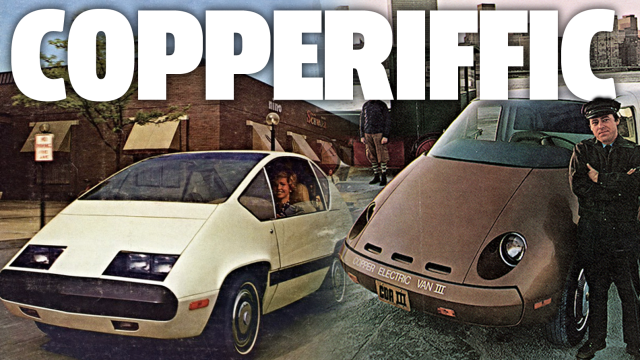It’s come to my attention that many people out there aren’t thinking about copper, the element with atomic number 29, all the time. In fact, many people only think of it as that stuff meth-heads like to strip from the walls of houses, but it’s really so very much more. For example, it’s a fantastic conductor of electricity, which is why the Copper Development Association (CDA) bothered to make some interesting electric cars back in the 1970s.
I’m genuinely fascinated with electric cars from the 1970s because it was both a crucial era for research and development of the modern electric car, and because the state of the art was so gloriously shitty that it’s an astounding testament to human optimism that people even kept trying to build these.
EVs of the 1970s were weird, heavy, slow and had miserable range. Other than that they were quiet and produced no emissions, they had pretty much zero benefits over combustion cars of the era, but electric dreamers kept trying, which is why we have superfast, long-range Teslas and Taycans today.
The CDA built three main classes of cars in the 1970s and early 1980s: the Copper Electric Town Car, the Runabout, and a van.
The designs of all of these cars are actually quite advanced for the era, and represent a lot of creative thinking; just because the fundamental battery and motor technology was so immature doesn’t mean that the designers didn’t do their absolute best to make the most of what they had.
The Town Car was really a pretty novel design—streamlined, roomy, a smooth underbelly, flush windows, and it had regenerative braking, even. Of course, it was stuck with 18 six-volt lead-acid batteries, and as such had a range of 160 kilometres at a constant 64 km/h, or 117 kilometres in stop-and-go driving.
Really, for the era, that was pretty damn good. Of course, it took you a hilarious 8.8 seconds to get to 48km/h mph, and the top speed was only 94 km/h. Laughable now, but state-of-the-art at the time.
If Town Car was the fancy lad, then the Runabout was the everyday city car workhorse. The tiny car sat four by having the rear seat cleverly facing backwards, like a Zündapp Janus, entering via the rear hatch.
Surprisingly, the performance from the 14 HP Runabout is better than the Town Car: it gets to 48km/h in 8.6 seconds (0.2 seconds quicker), and it matches the top speed of 94 km/h. Range is 127 kilometres in stop-and-go, and 115 km/h at a constant 64 km/h. Again, not too bad, considering the era.
I think the vans are the best-looking of the bunch, though, resembling cyborg space catfish, which I’m somehow considering a positive.
These vans used a 22 HP motor that could lug them to a top speed of 85 km/h, and they could haul up to 1,000 pounds of cargo. Range was a decent 152 kilometres with a full payload! Well, again at a constant 64 km/h, but still.
The vans were used by the Birmingham, Alabama as water metre checking vehicles, which seems an appropriately undemanding test job for them.
I really do love the look—it’s almost what you’d imagine a 1970s Porsche 911-based microbus would have looked like if you sorta squint just right.
